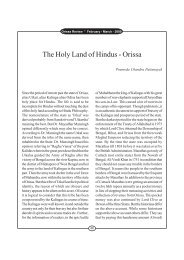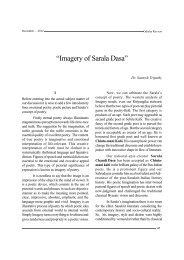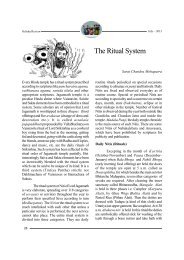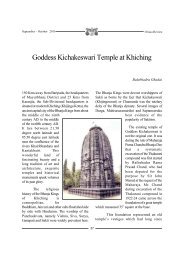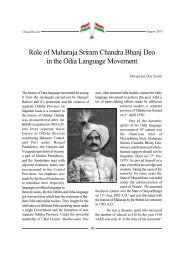The Cult of Saktism in Orissa - Government of Orissa
The Cult of Saktism in Orissa - Government of Orissa
The Cult of Saktism in Orissa - Government of Orissa
Create successful ePaper yourself
Turn your PDF publications into a flip-book with our unique Google optimized e-Paper software.
Bag Devi<br />
Bag Devi or Byaghra Devi is the tutelary<br />
deity <strong>of</strong> Bhanja dynasty <strong>of</strong> Southern <strong>Orissa</strong>,<br />
worshipped <strong>in</strong> Kulad fort <strong>of</strong> Ghumusar <strong>in</strong> Ganjam<br />
district. Orig<strong>in</strong>ally she was propitiated <strong>in</strong> one <strong>of</strong><br />
the caves <strong>of</strong> Bag Devi - mounta<strong>in</strong>, spread<strong>in</strong>g to<br />
the western side <strong>of</strong> the fort, on every Tuesday,<br />
untill she got enshr<strong>in</strong>ed <strong>in</strong> a temple constructed<br />
by late Dhananjaya Bhanja, grand-father <strong>of</strong> the<br />
great poet Upendra Bhanja.<br />
Eight armed goddess Bag Devi with bow<br />
and arrow sits on a tiger, press<strong>in</strong>g down a dead<br />
body. Ru<strong>in</strong>s <strong>of</strong> the palace are visible at a distance<br />
from the temple. Goddess Bag Devi is worshipped<br />
<strong>in</strong> both the temples on the top and bottom <strong>of</strong> the<br />
hill. <strong>The</strong> temple on the mounta<strong>in</strong> is known as 'Yoga<br />
Pitha' and at the bottom 'Bhoga Pitha' <strong>of</strong> goddess<br />
Bag Devi. On every Sankranti, Tuesdays <strong>of</strong> the<br />
month Chaitra and Durga Puja, the sanctum is<br />
crowded by people from all around. Dur<strong>in</strong>g<br />
Durga Puja goats are sacrificed to the Goddess.<br />
<strong>The</strong> tutelary deity <strong>of</strong> the royal family <strong>of</strong> Ghumusar<br />
became deity <strong>of</strong> the common people.<br />
Stambeswari<br />
Goddess Stambeswari (popularly known<br />
as Khambeswari) is the tutelary deity <strong>of</strong> Sonepur<br />
and Aska. Stambeswari <strong>of</strong> Sonepur is made <strong>of</strong><br />
timber - post with a face <strong>of</strong> vermillion pressed<br />
with metallic eyes, nose and mouth to <strong>in</strong>dicate<br />
the face <strong>of</strong> the Div<strong>in</strong>e Mother. Both tribal and<br />
not-tribal people worship Stambeswari although<br />
orig<strong>in</strong>ally she is associated with the Adivasis. <strong>The</strong><br />
Sevakas are known as 'Dumals'.<br />
Goddess Mother is worshipped <strong>in</strong> the<br />
form <strong>of</strong> two black wooden posts fixed to the<br />
ground, one Khamashiri and the other Paramishiri;<br />
the former be<strong>in</strong>g worshipped by Dumals and later<br />
by Brahm<strong>in</strong>s. <strong>The</strong> black colour <strong>of</strong> the goddess<br />
forbids Dumals to wear black cloth or black<br />
<strong>Orissa</strong> Review September - 2009<br />
36<br />
ornament. <strong>The</strong> women wear sari with red border<br />
and red glass bangles <strong>in</strong>stead <strong>of</strong> black and do not<br />
put mark <strong>of</strong> vermillion on their foreheads. Dumalas<br />
worship Khambeswari dur<strong>in</strong>g the month <strong>of</strong> Asw<strong>in</strong>.<br />
An ancient copper-plate <strong>of</strong> 5th - 6th<br />
century A.D., reveals the name <strong>of</strong> Khambeswari<br />
worshipped dur<strong>in</strong>g the regime <strong>of</strong> Maharaja<br />
Tustikara Dev. In the copper plates relat<strong>in</strong>g to<br />
Sulki K<strong>in</strong>g 'Kulastambeswari', Goddess Mother<br />
has been described as 'Bhattarika'.<br />
Stambeswari <strong>of</strong> Aska, one <strong>of</strong> the eight<br />
tribal goddesses named 'Khidis<strong>in</strong>g', was<br />
propitiated by the k<strong>in</strong>gs <strong>of</strong> Sului dynasty. Wooden<br />
Stambeswari <strong>of</strong> Non-Aryan (Kandha) orig<strong>in</strong> was<br />
later replaced by stone Stambeswari by Aryans.<br />
Common people believe that the wooden<br />
Stambeswari was transformed to stone<br />
Stambeswari by the grace <strong>of</strong> the Div<strong>in</strong>e Mother.<br />
But dur<strong>in</strong>g Durga Puja when the doors <strong>of</strong> stone<br />
Stambeswari get closed, goats are sacrificed to a<br />
wooden deity <strong>of</strong> two feet height kept <strong>in</strong> front <strong>of</strong><br />
stone Stambeswari. <strong>The</strong> wooden deity is perhaps<br />
no other than goddess Stambeswari orig<strong>in</strong>ally<br />
propitiated by tribal people.<br />
<strong>The</strong> face <strong>of</strong> stone Stambeswari <strong>of</strong> Aska<br />
is made <strong>of</strong> vermillion fixed with matallic eyes,<br />
nose and mouth. Some <strong>of</strong> the scholars br<strong>in</strong>g<br />
analogy between Stambeswari <strong>of</strong> Aska and<br />
Subhadra <strong>of</strong> Jagannath temple. To them,<br />
Subhadra was orig<strong>in</strong>ally like Stambeswari but<br />
transformed to present form dur<strong>in</strong>g the regime <strong>of</strong><br />
Ramachandra Dev <strong>in</strong> 16th century A.D. When<br />
goddess Subhadra is worshipped with<br />
Bhubaneswari Mantra, Stambeswari is<br />
worshipped with Bana Durga Mantra. Both the<br />
goddesses have been accepted as Vaishnavis.<br />
H<strong>in</strong>gula<br />
<strong>The</strong> temple <strong>of</strong> goddess H<strong>in</strong>gula is situated<br />
<strong>in</strong> a village named Gopal Prasad, near the rivulet




